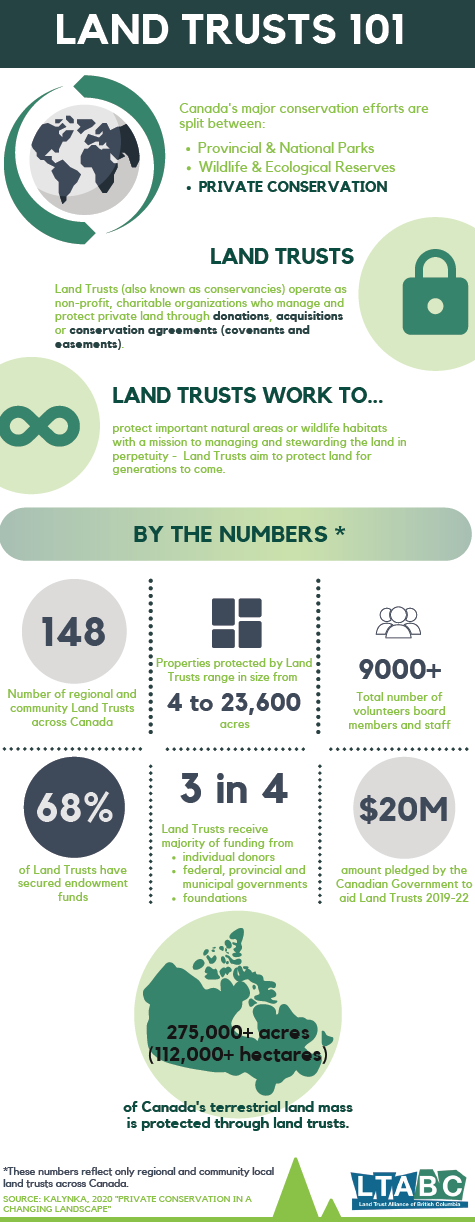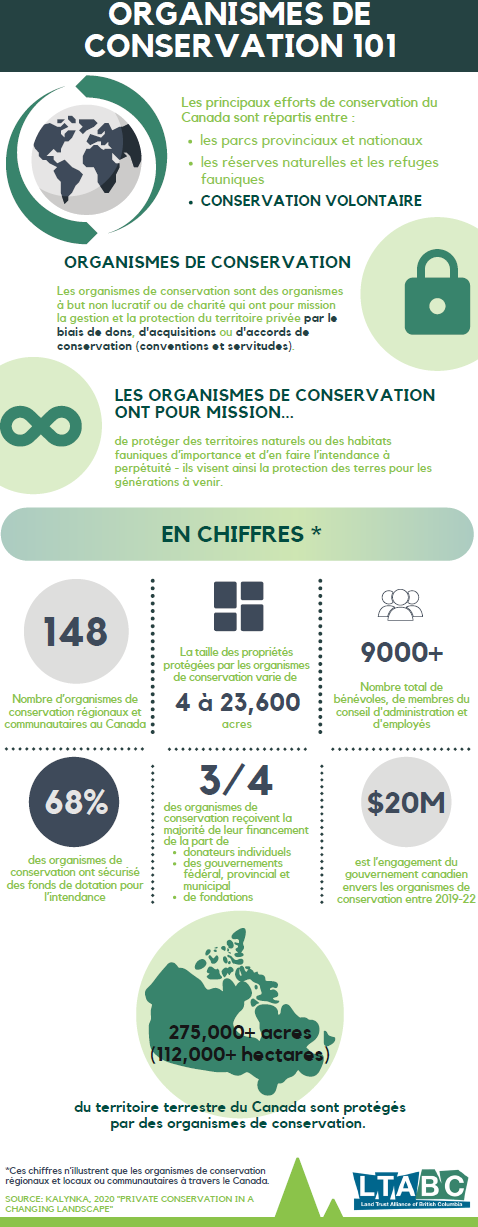Learn About Land Trusts
Land Trusts are the primary component to private land conservation and have become one of the fastest growing tools for biodiversity conservation on private land through property acquisitions and conservation agreements (conservation easements, covenants, and servitudes). In recent years, they have become the fastest growing tool for biodiversity conservation on privately owned land (Kalynka, 2020) yet their existence and impact is scarcely recognized throughout the public. Land trusts occupy an important niche in land conservation and in particular, the conservation of habitat particularly in regions with fragmented landscapes. Smaller properties in these regions provide the opportunity to ensure corridors for wildlife that lie between the larger protected spaces and especially for those species at risk. The mandates of each land trust is specific to the requirements of the environment it protects, but the general ethos of all land trusts is to protect important natural areas or wildlife habitats with a mission to manage and steward the land in perpetuity. Land Trusts aim to protect land for generations to come.
%
of Land Trusts have secured endowment funds
regional and community Land Trusts across Canada
Total number of volunteers board members and staff
The first land trust in Canada was established in Hamilton Ontario in 1919 as the Hamilton Naturalist Club. Since then, land trusts began slowly popping up around Canada and in the 1990s they started coming together to form alliances. These larger organizational bodies amplify the strength and resources of their member land trusts under a unified voice. By 1997, three alliances were established in British Columbia, Ontario and Quebec respectively, all of whom continue to this day. Land trusts range in size from small volunteer grassroots-based community organizations with modest budgets to provincial land trusts (Nova Scotia Nature Trust) to national land trusts (Nature Conservancy of Canada). In Canada, land trusts grew from approximately 60 in 1998 to over 148 in 2020 covering most of the habited Canada. As of 2021, they permanently protected near one (1) million acres of land.

Land trusts in Canada:
- Provide significant nature-based climate solutions through protection and restoration of carbon-rich habitats.
- Establish a network of protected spaces with corridors that protect critical habitat for species at risk and broader biodiversity.
- Contribute to the national goals of conserving 30% of land by 2030.
- Likely grow and gain greater economic importance particularly by contributing to ecological goods and services that would otherwise require infrastructure development.
Frequently Asked Questions About Land Trusts
What is a land trust?
Land trusts are a non-profit charitable organization that holds as its core values the conservation of private property through donation, acquisition and/or conservation agreements (easements and covenants).
What lands do land trusts protect?
As opposed to a government sponsored conservation area, these land trusts protect private land in perpetuity, assuring the land stays conserved for generations to come.
The hallmark of a land trust is the direct action they take to protect the local land base, and that they hold those lands or conservation easements in trust for future generations.
Who can form a land trust?
A Land Trust can be set up by a group eligible to form a non-profit charitable society or organization.
Why should you form a land trust?
- preserve and protect the ecological integrity of the land even though the land may be bought and sold
- protect habitats for other species and for the future sustainability of the ecosystem
- protect watershed areas, riparian areas, streams and other water sources
- protect heritage or cultural features of land
- maintain control over land and natural resources at the community level
- plan, protect, and manage for the long term needs of both the land and the people, rather than for short term economic returns from land speculation and development
- provide land or historical features as a community resource, educational tool, or area be stewarded in an ecologically appropriate manner
- place land and water (including agricultural, forestry or other human use areas) in trust for the common benefit of this and future generations of all life
- provide access to land and housing for people with a shared vision of stewardship which they could not otherwise afford to buy (generally referred as a Community Land Trust)
- provide a land base for community education/economic development
What steps are involved when forming a land trust?
- Decide what kind of a land trust you want to be and draft a mission and statement of purpose with clear objectives. Consider which Land Trust activities you want your land trust to undertake.
- Consider whether you will have the resources to do these activities.
- Consider the statement of purpose in the context of CCRA regulations for charitable organizations. (This is very important before drafting your Purpose & Goals within the Incorporation documents – some Purposes are not compatible with CCRA)
- Decide about membership and management Options include:
- membership organization which elects the board
- small society where all members are also directors
- society with directors appointed by another organization
- Recruit people with the goals and skills you need (both for the founding board and for future volunteers or staff).
- Do visioning workshops, board development, strategic planning etc., Make sure there is consensus about the big questions.
- Become familiar with the Societies Act, draft a constitution and bylaws, then apply for incorporation. This should be done carefully and thoughtfully, as weaknesses in the bylaws and constitution may come back haunt you later.
- Make application to CCRA for Charitable status.
- Join professional or other compatible, like-minded orgs like the LTABC, OLTA or RMN who can help you achieve your goals and purposes.
- Apply for general designation to hold Conservation covenants (after co-holding a covenant with another land trust.)
What are the general conservation tools of a land trust?
- Land trusts (or conservancies) usually provide Stewardship Education (schools, the community as a whole, landowners individually), hold Conservation Covenants or acquire lands outright.
- Tools include outright purchase, life estate, right of first refusal, conservation covenants, management agreements, leases, etc.
What tasks and activities are involved with operating a land trust?
- Fund raising for an operating budget, land acquisition, monitoring & stewardship programs and an endowment fund (for example, estimated “hard costs” of holding a covenant can run from 6 to 12k)
- Membership and public support (for volunteers, for donor support, for community support)
- Public education, information, and assistance with stewardship and conservation
- Partnerships with other organizations
- Land Acquisition
- Land protection
- Working with land owners and other land trusts to draft and hold conservation covenants
- Land Management
- Supervising, monitoring, and ensuring compliance forever
- Record keeping. Land trust activities create mounds of information which must be catalogued, protected and updated
- Communications & Training
- Policy, standard & practices development
- Board, Staff and volunteer recruitment & training
- Preparation and storage of documents, databases, photographs, legal documents etc.
- Research & Inventory of Priority areas, species, values and features for stewardship and conservation


